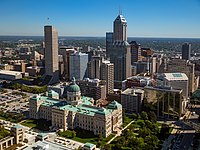
Photo from wikipedia
Abstract We conducted a post-construction survey of neighborhood preferences for street scale urban greenspace designed as green stormwater infrastructure (GSI) on vacant residential lots in Detroit, a city where greenspace… Click to show full abstract
Abstract We conducted a post-construction survey of neighborhood preferences for street scale urban greenspace designed as green stormwater infrastructure (GSI) on vacant residential lots in Detroit, a city where greenspace has potential to address structural inequities that characterize legacy cities and affect well-being. We investigated residents’ preferences related to their perceptions of microscale elements: immediately perceptible fine grain landscape characteristics of plants, landform, water, and structural materials. Our results suggest that microscale elements affect residents’ perceptions of care and safety, which are strongly related to preferences for landscape treatments on vacant lots near their homes. For each of two replicate pilot sites, we developed 15 alternative landscape treatments (including a control vacant lot). Across treatments, we varied microscale elements that could act as cues to care (CTC) or cues to safety (CTS). In a survey of all households within 250 m of the two sites, we measured residents’ perceptions of and preferences for alternative treatments. Among CTC, regular mowing was essential to preference, and low-growing shrubs and forbs with prominent flowers characterize the most preferred treatments. A CTS, bollards separating vacant lots from public access, were preferred for most treatments. Lots planted with many trees were preferred by a smaller percentage of residents, and their perceptions of care were less related to their preference. Overall, preferences are more well-explained by perceived care than by perceived safety. Furthermore, perceived care explains the effect of perceived safety on residents’ preferences for vacant lots near their homes.
Journal Title: Landscape and Urban Planning
Year Published: 2021
Link to full text (if available)
Share on Social Media: Sign Up to like & get
recommendations!